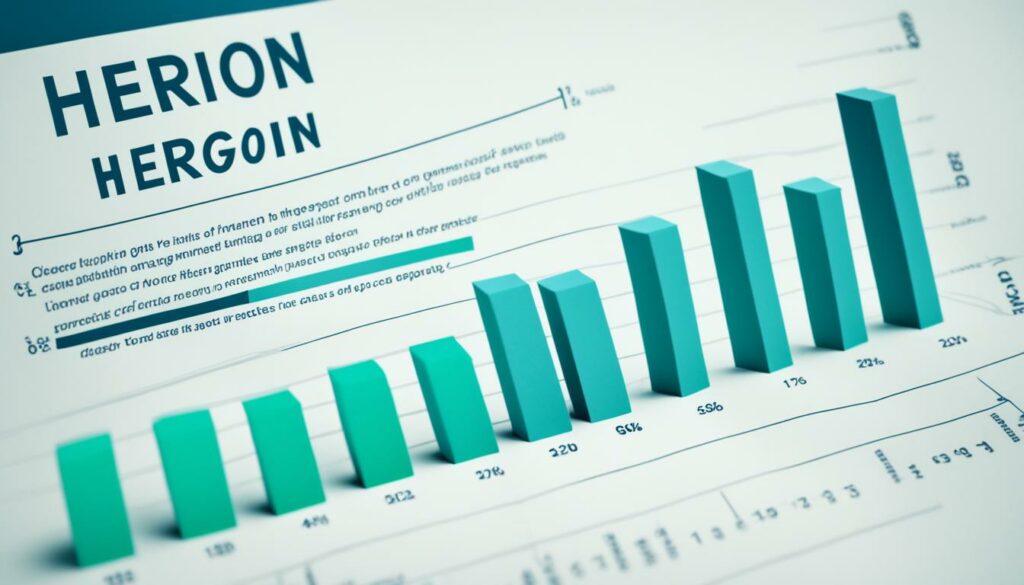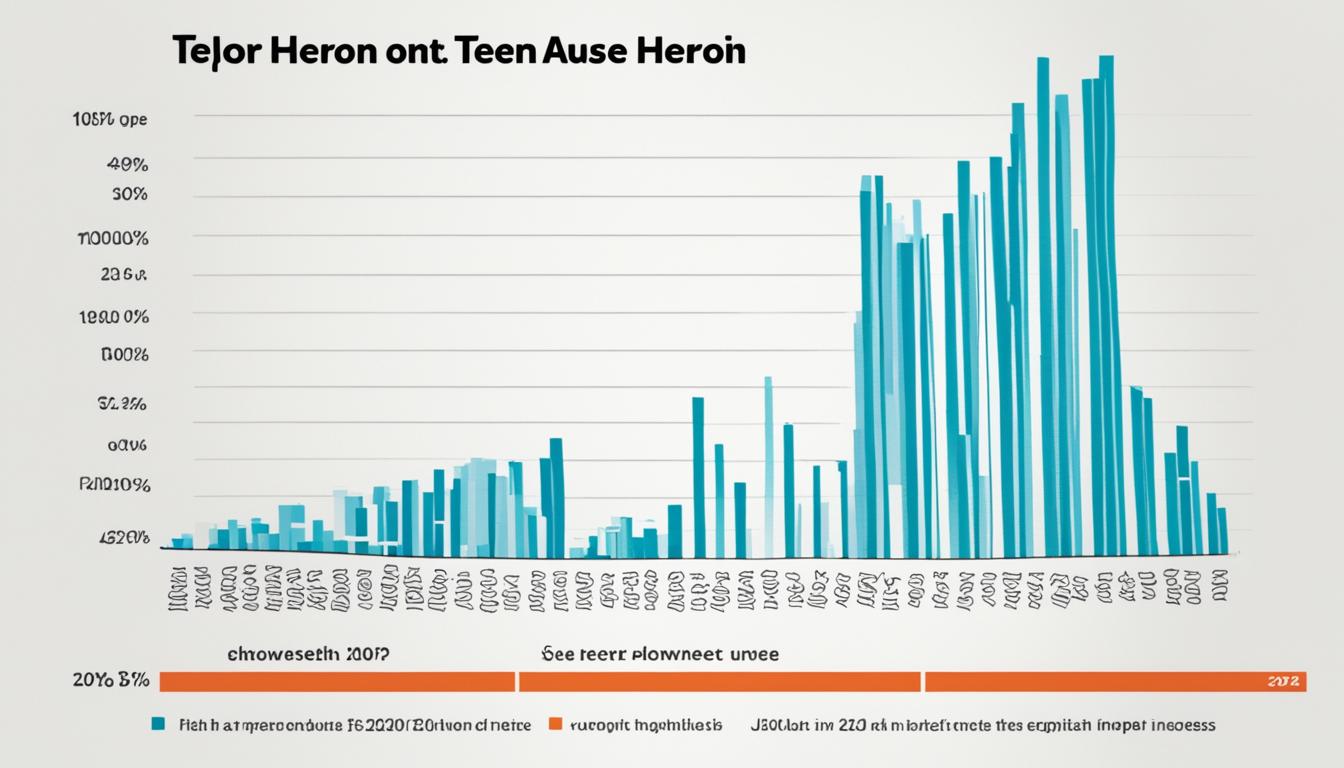Teen Heroin Use Statistics: Alarming Trends
When it comes to the growing concerns surrounding teenage drug abuse, heroin use among teenagers is a particularly alarming trend. The numbers paint a sobering picture of the current situation. According to the National Survey on Drug Use and Health (NSDUH), approximately 1 in 25 American adolescents aged 12 to 17 suffered from a substance use disorder in 2017. That’s around 992,000 teens who were grappling with drug-related issues.
While it’s unsettling to see such high numbers, it’s important to note that heroin use is just one part of a much larger problem. Among this group of teenagers, 1.8% had an alcohol use disorder, and 3% had an illicit drug use disorder. Furthermore, the use of heroin among young adults between the ages of 18 and 25 has doubled in the past decade. These statistics underscore the urgent need for attention and intervention to address this growing crisis.
Key Takeaways:
- Approximately 1 in 25 American adolescents aged 12 to 17 suffered from a substance use disorder in 2017.
- Heroin use among young adults between the ages of 18 and 25 has doubled in the past decade.
- 1.8% of American teenagers had an alcohol use disorder, while 3% had an illicit drug use disorder.
Substance Abuse Among Youth

Early drug abuse in youth often correlates with substance abuse problems later in life. In America, 8.33% of 12- to 17-year-olds, or approximately 2.08 million teenagers, reported using drugs in the last month. Among them, 83.88% reported using marijuana. Additionally, 591,000 teenagers used an illicit drug other than marijuana in the last month. By the time they’re in 12th grade, 46.6% of teens have tried illicit drugs.
Youth Drug Abuse Trends
Youth drug abuse trends reveal a concerning pattern of destructive behavior. Let’s take a closer look at the specific substance abuse problems among adolescents:
- Approximately 2.08 million teenagers, or 8.33% of 12- to 17-year-olds, reported using drugs in the last month.
- Out of these teenagers, 83.88% reported marijuana use as their drug of choice.
- There were 591,000 teenagers who used illicit drugs other than marijuana in the last month.
- By the time they reach 12th grade, 46.6% of teens have experimented with illicit drugs.
These statistics highlight the urgent need for effective preventive measures and early intervention strategies to tackle adolescent heroin abuse and other substance abuse problems.
“Substance abuse is not just a passing phase for many teenagers; it can have long-term consequences on their physical and mental health,” says Dr. Rebecca Adams, a leading expert on adolescent drug abuse.
| Substance | Percentage of 12- to 17-year-olds |
|---|---|
| Marijuana | 83.88% |
| Illicit drugs other than marijuana | 591,000 teenagers |
| Overall illicit drug use in 12th grade | 46.6% |
Youth Alcohol Abuse

Alcohol use among teenagers is a concerning issue with far-reaching consequences. According to recent studies on teen substance abuse rates, approximately 9.15% of 12- to 17-year-olds in the United States have used alcohol in the last month. This prevalence highlights the need for effective prevention and intervention strategies to address the underlying causes of alcohol abuse in this vulnerable age group.
One particularly alarming aspect of youth alcohol abuse is the prevalence of binge drinking. A staggering 60.2% of teenagers who consume alcohol engage in binge drinking, which is defined as consuming a large quantity of alcohol within a short period resulting in a blood alcohol concentration (BAC) of 0.08% or higher.
“Binge drinking can have severe consequences on the physical and mental health of teenagers,” says Dr. Sarah Johnson, a leading expert in adolescent substance abuse. “It increases the risk of accidents, injuries, and even alcohol poisoning. Furthermore, it impairs judgment, contributes to risky behaviors, and can lead to long-term alcohol use disorder.”
Indeed, alcohol use disorder (AUD) is a widespread issue among teenagers. Approximately 407,000 teenagers meet the criteria for AUD in a single year, highlighting the need for early intervention and evidence-based treatment options.
Prevalence of Heroin Use in Teens
While alcohol is the most commonly abused substance among teenagers, it is crucial to discuss the prevalence of heroin use in this demographic. Although heroin use is relatively low among teenagers compared to alcohol and marijuana, even a small percentage of adolescents experimenting with heroin has significant implications for their health and well-being.
In a comprehensive study conducted by the Substance Abuse and Mental Health Services Administration (SAMHSA), it was found that 0.02% of 12- to 17-year-olds reported using heroin in the last year. While the percentage may seem small, it represents a substantial number of teenagers who are putting themselves at great risk.
Key Statistics:
| Demographic | Prevalence of Heroin Use |
|---|---|
| 12- to 17-year-olds | 0.02% |
| 18- to 25-year-olds | 0.17% |
The table above depicts a comparison between the prevalence of heroin use in teenagers and young adults. It is essential to address the underlying factors that contribute to heroin experimentation in adolescence to prevent the potential development of heroin use disorder in adulthood.
In conclusion, the high rates of alcohol use and binge drinking among teenagers emphasize the urgent need for preventive measures and effective interventions. Additionally, while the prevalence of heroin use in teens may be relatively low, any percentage of young people experimenting with such a dangerous substance necessitates targeted efforts to prevent future heroin use disorders.
Youth Drug Abuse

In addition to alcohol, youth drug abuse involves the misuse of illicit drugs. It is crucial to understand how prevalent this issue is among adolescents.
About 741,000 adolescents aged 12 to 17 suffered from an illicit drug use disorder in 2017. This alarming statistic highlights the urgent need for effective prevention and intervention strategies to address this growing problem.
Marijuana stands out as the most commonly abused illicit drug among teenagers, with approximately 12.78% of all 12- to 17-year-olds reporting its use in the last year. The easy accessibility and perceived innocuousness of marijuana contribute to its popularity among young individuals.
While marijuana is prevalent, other illicit drug use among teenagers includes:
- Cocaine – 0.42%
- Methamphetamines – 0.17%
- Heroin – 0.02%
These statistics demonstrate that youth drug abuse extends beyond marijuana, encompassing a range of dangerous substances. It is crucial for parents, educators, and healthcare professionals to remain vigilant in identifying and addressing these issues to safeguard the well-being of our youth.
Marijuana Abuse

Marijuana is a prevalent illicit substance among adolescents, with a significant number of young individuals experimenting with its usage. According to recent statistics, 43.7% of 12th graders in the United States have tried marijuana at least once in their lifetime. Additionally, 6.9% of 12th graders are daily marijuana users. These figures highlight the need for effective preventive measures and educational initiatives to address marijuana abuse among adolescents.
One concerning trend is the use of synthetic marijuana, also known as spice or K2, among youth. Synthetic marijuana is a human-made substance designed to mimic the effects of natural marijuana. It is often marketed as a legal alternative, but its use can have severe health consequences. In the last year, 2.4% of adolescents reported using synthetic marijuana. The unpredictable nature of synthetic marijuana compounds poses a significant risk and underscores the importance of promoting awareness about its dangers.
Furthermore, marijuana consumption methods have evolved, with an increasing number of young individuals turning to vaping as a preferred method. Among 12th graders, 62.8% reported using marijuana through vaping devices. Vaping provides a discreet and convenient way for adolescents to consume marijuana, making it more challenging for parents and educators to detect and address usage.
“The rising prevalence of marijuana abuse among adolescents calls for comprehensive efforts to educate young individuals about its potential risks and implement evidence-based prevention strategies.”
Marijuana Usage Trends in Adolescents
| Statistic | Percentage |
|---|---|
| 12th graders who have tried marijuana in their lifetime | 43.7% |
| 12th graders who use marijuana daily | 6.9% |
| Adolescents who have used synthetic marijuana in the last year | 2.4% |
| 12th graders who consume marijuana through vaping | 62.8% |
The table above provides an overview of the latest statistics regarding marijuana usage among adolescents, highlighting the prevalence of its use and the adoption of alternative consumption methods.
To address the growing issue of marijuana abuse among adolescents, it is crucial to implement comprehensive prevention programs that emphasize the potential risks associated with its usage. Educating young individuals about the detrimental effects of marijuana on their physical and mental health can empower them to make informed decisions and resist peer pressure. Additionally, fostering open communication between parents, educators, and teenagers can create a supportive environment for seeking help and early intervention if needed.
Opioid Abuse
Opioid abuse, including heroin, is considered a national public health emergency. >Opioid-related overdose deaths among 15- to 24-year-olds have increased by 500% since 1999, and 0.4% of 12th graders have abused heroin. Additionally, 2.4% of 12th graders abused OxyContin in the past year, and 1.2% abused Vicodin.
Opioid-Related Overdose Deaths Among Adolescents
“Opioid abuse is a critical issue affecting young people in America. The alarming increase in opioid-related overdose deaths among adolescents is deeply concerning. We must take immediate action to address this devastating crisis and protect our youth from the harmful effects of opioid abuse.”
According to recent data, opioid-related overdose deaths among 15- to 24-year-olds have skyrocketed in the past two decades, increasing by a staggering 500% since 1999. This rise in opioid-related fatalities highlights the urgent need for comprehensive prevention and treatment strategies to combat adolescent heroin abuse.
These disturbing statistics underscore the gravity of the opioid epidemic and the devastating impact it has on young lives. Adolescents are particularly vulnerable to the allure of opioids due to factors such as peer influence, emotional distress, and exposure to prescription opioids.
Prevalence of Adolescent Heroin Abuse
Heroin abuse is a significant concern among teenagers. While the percentage of 12th graders who abuse heroin remains relatively low at 0.4%, it is important to recognize the potential consequences and long-term effects of heroin use on young individuals.
Heroin, a highly addictive opioid, poses a severe risk to adolescent health and well-being. Its potency and addictive properties make it particularly dangerous for youthful experimentation. Early intervention, education, and support systems are crucial in preventing and addressing adolescent heroin abuse.
Prescription Opioid Abuse Among Adolescents
Prescription opioids, such as OxyContin and Vicodin, also contribute to the opioid crisis among adolescents. Shockingly, 2.4% of 12th graders abused OxyContin in the past year, while 1.2% abused Vicodin.
These figures emphasize the need to address the misuse and diversion of prescription opioids among young people. Strict regulation, comprehensive education programs, and accessible treatment options must be implemented to combat prescription opioid abuse and prevent the progression to heroin use.
| Substance | Abuse Rate Among 12th Graders (Past Year) |
|---|---|
| OxyContin | 2.4% |
| Vicodin | 1.2% |
Prescription Stimulant Abuse: A Growing Concern Among Youth
Prescription stimulant abuse is a significant issue affecting young individuals, surpassing the abuse of cocaine and amphetamines. According to recent data, 8.9% of 8th graders have experimented with amphetamines in their lifetime, showcasing a concerning trend. Furthermore, 1.1% of 8th graders have tried methamphetamine, an alarming statistic considering the risks associated with this potent stimulant.
The abuse of prescription stimulants, such as Adderall or Ritalin, is often driven by the misperception that these medications can enhance academic performance or induce weight loss. However, the misuse of these drugs can lead to severe consequences, including addiction, cardiovascular complications, and psychiatric issues.
“The misuse of prescription stimulants among youth is a pressing concern that demands immediate attention. It is crucial for parents, educators, and healthcare professionals to educate young individuals about the risks associated with these drugs and promote healthier alternatives for managing academic and personal challenges.”
In addition to prescription stimulants, the abuse of cocaine still remains a troubling issue among teenagers. Approximately 1.6% of 12th graders have experimented with crack cocaine at least once, highlighting the need for comprehensive drug prevention and intervention programs.
To raise awareness and combat the growing problem of prescription stimulant abuse, it is important to engage in open conversations with young individuals, providing them with accurate information about the potential consequences of substance misuse. By addressing the underlying motivations behind drug abuse and promoting healthy coping mechanisms, we can strive to create a safer and healthier future for our youth.
Youth Drug Abuse by State
Drug abuse rates among youth vary by state and region, highlighting regional drug abuse patterns and geographical variation. Understanding these differences is crucial for developing targeted prevention and intervention strategies. Let’s take a closer look at some drug abuse statistics by state:
Alcohol Use Disorder (AUD) by State
| State | Prevalence of AUD among Youth |
|---|---|
| Montana | Highest prevalence |
| California | Moderate prevalence |
| New York | Low prevalence |
Illicit Drug Use Disorder (IDUD) by State
| State | Prevalence of IDUD among Youth |
|---|---|
| Vermont | Highest prevalence |
| Texas | Moderate prevalence |
| Alabama | Low prevalence |
Drug Abuse Among 12- to 17-Year-Olds by Region
- Western states and New England have the highest rates of drug abuse among 12- to 17-year-olds.
- Southern states have moderate rates of drug abuse.
- Midwestern and Mid-Atlantic states have relatively lower rates of drug abuse.
“Understanding and addressing the regional variations in drug abuse patterns is crucial in developing effective prevention and intervention strategies for youth.”
It’s evident that drug abuse among youth is influenced by various factors, including social and economic conditions, cultural influences, and the availability of substances. By recognizing these differences, policymakers, educators, and healthcare professionals can tailor their efforts to address the specific needs and challenges of each region.
Elderly Individuals and Substance Abuse
Substance use disorders also affect the elderly population. It is estimated that approximately 1 million individuals aged 65 and older had a substance use disorder in 2017. Among them, 978,000 had an alcohol use disorder, while 93,000 had an illicit drug use disorder.
It is important to note that between 21% and 66% of elderly individuals battling a substance use disorder also suffer from a co-occurring mental health disorder. This highlights the complex nature of substance abuse among the elderly and the need for integrated treatment approaches that address both the substance use disorder and the underlying mental health issues.
“Substance use disorders can have a significant impact on the well-being and quality of life of elderly individuals. It is crucial that we raise awareness and provide appropriate support and resources for this vulnerable population.”
To better understand the prevalence of substance abuse among the elderly, let’s take a look at the following table:
| Substance Use Disorder | Number of Elderly Individuals (2017) |
|---|---|
| Alcohol Use Disorder | 978,000 |
| Illicit Drug Use Disorder | 93,000 |
Conclusion
Teen heroin use and drug abuse among adolescents continue to be a significant public health concern in the United States. The prevalence of substance use disorders and the misuse of various substances highlights the need for comprehensive prevention and treatment programs targeting youth. It is crucial that we address the underlying factors contributing to drug abuse and provide support for those affected by addiction.
The implications of heroin use among teens cannot be understated. Heroin addiction can lead to severe physical, mental, and social consequences, impacting not only the individuals involved but also their families and communities. The destructive cycle of substance abuse needs to be broken through education, awareness, and intervention strategies.
Efforts must be made to create a supportive environment for teenagers struggling with drug abuse. This includes implementing evidence-based prevention programs in schools, providing accessible treatment options, and fostering positive social support networks. By empowering young individuals with the knowledge and resources they need, we can help them make informed decisions about their health and well-being.
It is essential that parents, educators, healthcare professionals, and policymakers work together to combat teenage drug abuse effectively. By addressing the root causes, providing early intervention, and offering ongoing support, we can make a lasting impact and prevent the devastating consequences of drug addiction among our youth.
FAQ
How many teenagers use heroin?
According to the data, approximately 0.02% of teenagers have reported using heroin.
What are the statistics on teen heroin use?
The statistics show that the use of heroin among teenagers is a significant concern, with a small but alarming percentage of adolescents engaging in heroin abuse.
What are the trends in adolescent drug abuse?
Adolescent drug abuse is a growing problem, with reported rates of substance use disorders increasing among young people in recent years.
How prevalent is alcohol abuse among teens?
Alcohol abuse is a common issue among teenagers, with a significant number of adolescents reporting alcohol use and binge drinking.
What is the prevalence of illicit drug use among youth?
Illicit drug use among youth is a concerning issue, with a considerable number of teenagers reporting using drugs other than marijuana.
What is the prevalence of marijuana use among teenagers?
Marijuana is one of the most commonly used illicit substances among teenagers, with a significant percentage of high school seniors reporting lifetime and current use.
How big of a problem is opioid abuse among youth?
Opioid abuse among youth is a significant public health concern, with a growing number of adolescents abusing heroin and prescription opioids.
What are the trends in stimulant abuse among youth?
Prescription stimulant abuse is a prevalent issue among young people, surpassing the misuse of cocaine and amphetamines.
How does drug abuse among youth vary by state?
The rates of drug abuse among youth vary by state, with certain regions of the country experiencing higher levels of substance abuse than others.
Is substance abuse a problem among elderly individuals?
Substance abuse among elderly individuals is an issue that must be addressed, with a significant number of older adults experiencing alcohol and drug use disorders.
What are the implications of heroin use among teenagers?
The use of heroin among teenagers has wide-ranging implications for public health and highlights the need for comprehensive prevention and treatment programs.







